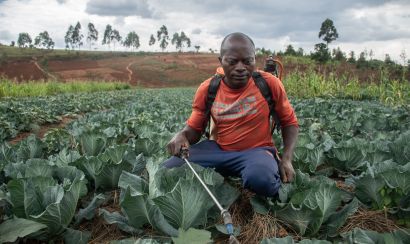Smallholder Farming - at the Centre of our Food Systems
Apart from its nutritional value, food systems are crucial to our economies - agriculture accounts for four percent of global GDP. In Sub-Saharan Africa, where about 50% of the region's workforce engages in farming, the sector accounts for at least 20% of GDP.
At the heart of Africa's agriculture are smallholder farmers, some 33 million hardworking individuals who typically farm on less than a hectare of land.

These farmers grow staple crops such as maize, wheat, rice, cassava, and sorghum. They also play a vital role in environmental sustainability and conservation by engaging in agroforestry and crop diversification, among other practices.
7 key things to know about smallholder farmers and smallholder farming
- Smallholder farming is often rain-fed - meaning the only source of water used comes from the sky!
- Small farms depend predominantly on family labor, although they may hire outside help.
- Smallholder farmers produce relatively small food volumes on small plots of land (compared to large or commercial-scale farmers).
- They produce primarily for local consumption, but their commodities, such as maize, macadamia, and avocado, can find their way into the export market.
- Smallholders generally have fewer resources and technology than commercial-scale farmers. For example, they might till their land by hand instead of using tractors.
- Smallholders are often considered part of the informal economy – their livelihoods depend on the natural resource base and informal networks to access markets.
- These farmers are also vulnerable to climate and market price fluctuations.
Small, but mighty!
The FAO estimates that 70 percent of the world's 570 million farms are less than one hectare. Altogether, farms that are less than five acres account for less than 20 percent of all agricultural land across the world.
Despite their small operational scale, smallholder farmers produce food for a substantial proportion of the world's population. Overall, they have a high crop diversity that favors good nutrition and market diversification. They are also environmental stewards who adopt practices such as mulching, intercropping, and agroforestry, which are essential for mitigating the risk of drought in the short term and developing productive, sustainable, and resilient food systems over the long term.
A challenging profession
However, smallholder farmers face many challenges - three of the biggest are access to finance and quality inputs, climate change and market access.
Access to finance and quality inputs
When farmers cannot access affordable agricultural finance, they cannot afford planting supplies, most often seed and fertilizer. This, in turn, means they miss being able to plant when the rains start each planting season - a critical moment given the majority of them practice rain-fed agriculture. As a result, they often fail to meet their farms' production potential, with serious implications for food and nutrition security and livelihoods.
Climate change
Climate change is also causing lots of problems for smallholders. Climate change alters the growing conditions of entire regions, affecting rain patterns and making production unpredictable. Inevitably, farmers who depend on rain are most affected by the effects of our changing climate. Climate change also causes environmental degradation, water supply fluctuations, including floods, droughts, and severe storms. These events lead to scenarios such as low soil fertility, a reduction in arable land suitable for agricultural production, erosion, depletion of water bodies and reduced rainfall, and high incidences of pests and diseases that affect crop productivity and livestock health.
Market access
Market access is another big challenge; smallholders lack reliable, fair markets to sell their produce. Because most farmers live in remote places, it’s often difficult for them to reach markets, with high transportation costs a big constraint. This is really problematic because after harvesting, many smallholder farmers need to sell their crops quickly because they don’t have ideal storage facilities.
Providing access to finance, quality supplies and training
Supplying farmers with asset-based financing and agriculture training services is a practical way of increasing the productivity of small farms and reducing hunger and poverty.
One Acre Fund provides Eastern Africa's smallholders with farming supplies – seed and fertilizer – on credit, and agriculture training services, to enable them to increase and sustain their farms' production. Farmers enjoy a flexible repayment system that allows them to pay back their loans in any amount throughout the growing season. Besides accessing credit options, farmers also benefit from market facilitation through storage solutions and marketing training.
"I am happy that I get all my planting inputs at the beginning of the season and do not have to worry about low yields. I am happy about the huge difference that I see in my harvests then and now. I not only get enough food, but I also get money for my family's other needs from the same piece of land," — Ulia Msigwa, Iringa - Tanzania.

Building climate resiliency
Even with increased access to all of these services, products, and information, climate change poses a threat to smallholders. This is why increasing focus on climate resiliency practices such as climate-smart agriculture (CSA) is critical. CSA strategies, which help farmers maintain their productivity even during challenging weather, include products and services that generate income impact and enhance a farm's long-term sustainability. Trees, for example, fix soil health and provide long-term, stable assets; crop diversification ensures farmers can still eat even when one crop suffers; adopting planting styles like trenching and furrow planting prevents soil erosion in flood-prone areas, and applying compost helps enrich soil and maintain its health.
"We want our families to eat better. We want to have more than just maize to sell. Since 2018, everyone in my group has been ordering trees. We want to prevent soil erosion, and planting trees is a sustainable solution. The varieties we have do not damage food crops. We want to grow them into maturity as a long-term investment," — Betty Nafuna, Kakamega - Kenya.




